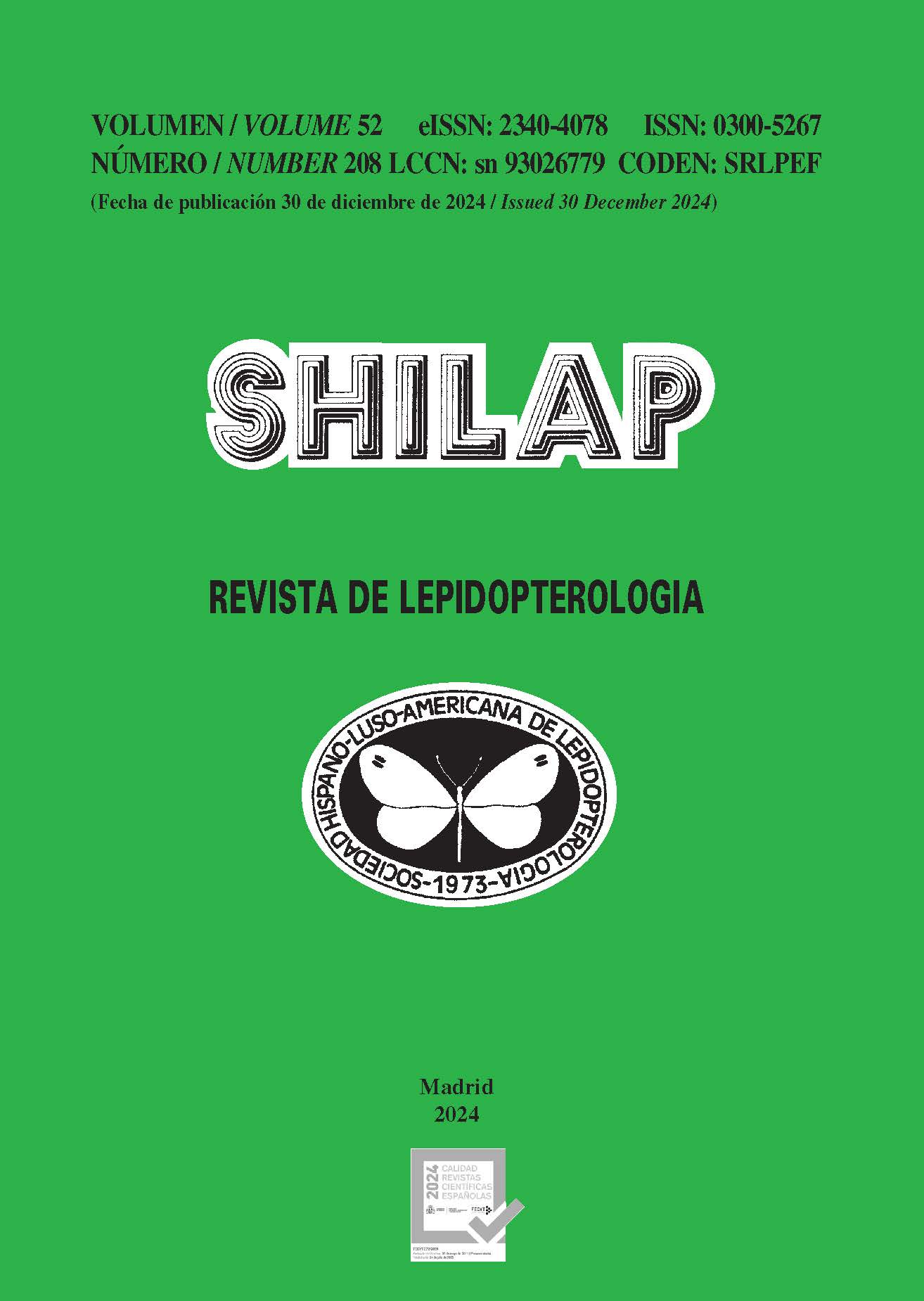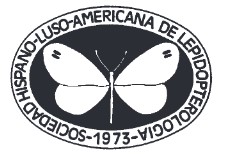Imma phuocbuu Buchsbaum, Chi & Chen, sp. nov. from south Vietnam (Lepidoptera: Immidae)
DOI:
https://doi.org/10.57065/shilap.1016Palavras-chave:
Lepidoptera, Immidae, Imma phuocbuu, new species, distribution, biotope, taxonomy, VietnamResumo
During a faunal survey of Lepidoptera in 2023, Imma phuocbuu Buchsbaum, Chi & Chen, sp. nov. was discovered and represents the first record of the genus in Vietnam. A single male specimen was collected from a transitional biotype between mangrove and semi-deciduous dry lowland forest habitats near the coast. The new species is distinguished from Imma transversella (Snellen, 1878), I. semicitra Meyrick, 1937 and I. semiclara Meyrick, 1929 by differences in wing pattern and genitalia morphology.
Downloads
Estatísticas globais ℹ️
|
601
Visualizações
|
139
Downloads
|
|
740
Total
|
|
Referências
Averyanov, L. V., Loc, PO. K., Hiep, N. T., & Harder, D. K. (2003). Phytogeographyc review of Vietnam and adjected areas of Eastern Indochina. Komarovia, 3, 1-83.
Brooks, T (2010). Conservation planning and priorities, Chapter 11. In N. S. Sodhi & P. R. Ehrlich (eds.). Conservation Biology for All, Oxford, 2010, 199-219. https://doi.org/10.1093/acprof:oso/9780199554232.003.0012 DOI: https://doi.org/10.1093/acprof:oso/9780199554232.003.0012
Brooks, T. M., Mittermeier, R. A., Mittermeier, C. G., da Fonseca, G. A. B., Rylands, A. B., Konstant, W. R., Flick, P., Pilgrim, J., Oldfield, S., Magin, G., & Hilton-Taylors, C. (2002). Habitat Loss and Extinction in the Hotspots of Biodiversity. Conservation Biology, 16(4), 909-923. https://doi.org/10.1046/j.1523-1739.2002.00530.x DOI: https://doi.org/10.1046/j.1523-1739.2002.00530.x
Buchsbaum, U., Grehan, J. R., Chen, M.-Y., Chi, N. M., Pham, D. L., Khai, T. Q., Jones, L. D., & Ignatev, N. (2022). New species of Endoclita C. and R. Felder, 1874 and first record of. E. salvazi from Vietnam (Insecta: Lepidoptera: Hepialidae). Vernate, 41, 267-286.
Buchsbaum, U. (2019). A new species of the genus Ceneressa Obraztsov, 1957 from northern Thailand (Lepidoptera, Erebidae, Arctiinae, Syntomini). Nachrichten des entomologischen Vereins Apollo, N. F., 40(1), 62-64.
Buchsbaum, U., Brüggemeier, F., & Chen, M.-Y. (2014). A new species of the genus Callidrepana Felder, 1861 from Laos (Lepidoptera, Drepanidae). Entomofauna, Supplement, 17, 45-53.
Callighan, C. J. (2009). The Riodinid Butterflies of Vietnam (Lepidoptera). Journal of the Lepidopterologists’ Society, 63(2), 61-82.
Cerny, K., & Pinratana, B. A. (2007). Arctiidae. Moths of Thailand (Vol. 6). Brothers of Saint Gabriel.
Clarke, J. F. G. (1986). Pyralidae and Microlepidoptera of the Marquesas Archipelago. Smithsonian Contributions to Zoology, Washington, 416. https://doi.org/10.5479/si.00810282.416 DOI: https://doi.org/10.5479/si.00810282.416
De Lattin, G. (1967). Grundriss der Zoogeographie. VEB Gustav Fischen Verlag Jena.
Diakonoff, A. (1986). Glyphipterygidae auctorum sensu lato (Glyphipterygidae sensu Meyrick, 1913); Tortricidae: Hilarographini, Choreutidae, Brachodidae (partim), Immidae and Glyphipterygidae. Microlepidoptera Palaearctica (Vol. 7). G. Braun.
Dugdale, J.S., Kristensen, N.P., Robinson, G.S. & Scoble. M.J. (1999) The smaller Microlepidoptera-Grade Superfamiles. In: Kristensen, N.P. (ed.), Handbook of Zoology, volume 4, Arthropoda: Insecta, part 35. Lepidoptera, moths and butterflies, volume 1: Evolution, Systematics, and Biogeography. Walter de Gruyter. DOI: https://doi.org/10.1515/9783110804744.217
Fa, J. E., & Funk, S. M. (2007). Global endemicity centres for terrestrial vertrebrates: an ecoregions approach. Endangered Species Research, 3, 31-52. https://doi.org/10.3354/esr003031 DOI: https://doi.org/10.3354/esr003031
Heppner, J. B. (1977). The status of the Glyphipterigidae and a reassessment of relationships in Yponomeutoid families and ditrysian superfamilies. Journal of the Lepidopterists’ Society, 31, 124-134.
Heppner, J. B. (1982a). Review of the family Immidae, with a world checklist (Lepidoptera: Immoidea). Entomography, 1, 257-279.
Heppner, J. B. (1982b). Synopsis of the Glyphipterigidae (Lepidoptera: Copromorphoidea) of the world. Proceedings of the Entomological Society of Washington, 84, 38-66.
Heppner, J. B. (1991). Faunal Regions and the Diversity of Lepidoptera. Tropical Lepidoptera, 2(Suppl. 1), 1-85.
Holloway, J. D., Kibby, G., & D. Peggie (2001). The Families of Malesian moths and butterflies. Brill. https://doi.org/10.1163/9789004475595 DOI: https://doi.org/10.1163/9789004475595
Kier, G., Kraft, H., Lee, T. M., Jetz, W., Ibisch, P. L., Nowicki, C., Mutke, J., & Barthlott, W. (2009). A global assessment of endemism and species richness across island and mainland regions. PNAS, 106(23), 9322-9327. https://doi.org/10.1073/pnas.0810306106 PMid:19470638 PMCid:PMC2685248 DOI: https://doi.org/10.1073/pnas.0810306106
Küppers, P. V., & Buchsbaum, U. (2015). Phacusa janikornae sp. n. from South Thailand (Lepidoptera, Zygaenidae, Procridinae) with description of the biology. Nachrichten des entomologischen Vereins Apollo, N. F., 36(2/3), 148-152.
Manh, V. Q. (2015). Zoogeographical division of Vietnam based on the Oribatid Mite (Acari: Oribatida) Fauna. Tap Chi Sinh Hoc, 37(3), 353-361. https://doi.org/10.15625/0866-7160/v37n3.7592 DOI: https://doi.org/10.15625/0866-7160/v37n3.7592
Marchese, C. (2015). Biodiversity hotspots: A shortcut for more complicated concept. Global Ecology and Conservation, 3, 297-309. https://doi.org/10.1016/j.gecco.2014.12.008 DOI: https://doi.org/10.1016/j.gecco.2014.12.008
Ministery of Natural Resources and Environment (MONRE) (2020). Vietnam National Biodiversity Strategy to 2020, Vision to 2030. Hanoi.
Mittermeier, R. A., Turner, W. R., Larsen, F. W., Brooks, T. M., & Gascon, C. (2011). Global Biodiversity Conservation: the Critical Role of Hotspots, Chapter 1. In F. E. Zachos & J. C. Habel (eds.). Biodiversity Hotspots. https://doi.org/10.1007/978-3-642-20992-5_1 DOI: https://doi.org/10.1007/978-3-642-20992-5_1
Mittermeier, R. A., Myers, N., Thomsen, J. B., da Fonseca, G. A. B., & Olivieri, S. (1998). Biodiversity Hotspots and Major Tropical Wilderness Areas: Approaches to Setting Conservation Priorities. Conservation Biology, 12(3), 516-520. https://doi.org/10.1046/j.1523-1739.1998.012003516.x DOI: https://doi.org/10.1046/j.1523-1739.1998.012003516.x
Myers, N., Mittermeier, R. A., Mittermeier, C. G., da Fonseca, G. A. B., & Kent, J. (2000): Biodiversity hotspots for conservation priorities. Nature, 403, 853-858. https://doi.org/10.1038/35002501 PMid:10706275 DOI: https://doi.org/10.1038/35002501
Olson, D. M., & Dinerstein, E., (2002). The Global 200: Priority Ecoregions for Global Conservation. Annals of the Missouri Botanical Garden, 89(2), 199-224. https://doi.org/10.2307/3298564 DOI: https://doi.org/10.2307/3298564
Phuong, V. T., & Lin, T. M. (2011). Final report on Forest Ecological Stratification in Vietnam. UN-REDD Programme Vietnam.
Robinson, G. S. (1976). The preparation of slides of Lepidoptera genitalia with special reference to the Microlepidoptera. Entomologist’s Gazette, 27, 127-132.
Robinson, G. S., Tuck, K. R., & Shaffer, M. (1994). A Field Guide to the smaller moths of South-East Asia. Malaysian Nature Society.
Schintlemeister, A. (1997a). Moths of Vietnam with special reference to Mt. Fan-si-pan. Introduction and collection localities. Entomofauna, Supplement, 9(1), 1-12.
Schintlemeister, A. (1997b). Moths of Vietnam with special reference to Mt. Fan-si-pan. Family Notodontidae. Entomofauna, Supplement, 9(4), 33-248.
Schintlmeister, A. (2001). Zoogeographie vietnamesischer Heterocera unter besonderer Berücksichtigung der Zahnspinner (Lepidoptera: Notodontidae). Phyllodrom-Journal. Abhandlungen und Berichte aus der Regenwaldforschung. Tagungsberichte / Phyllodrom-Journal. Abhandlungen und Berichte aus der Regenwaldforschung. Tagungsberichte (Vol. 1, pp. 89-90).
Schintlmeister, A. (2003). The zoogeography of Taiwans’s Notodontidae (Lepidoptera). Journal of the Zoological Society Wallacea, 1, 15-26.
Schintlmeister, A., & Pinratana, B. A. (2007). Moths of Thailand. Notodontidae (Vol. 5). Brothers of Saint Gabriel. https://doi.org/10.1163/9789004260993 DOI: https://doi.org/10.1163/9789004260993
Sechrest, W., Brooks, T. M., de Fonseca, G. A. B., Konstant, W. R., Mittermeier, R. A., Purvis, A., Rylands, A. B., & Gittleman, J. L. (2002). Hotsspots and the conservation of evolutionary history. PNAS, 99(4), 2067-2071. https://doi.org/10.1073/pnas.251680798 PMid:11854502 PMCid:PMC122320 DOI: https://doi.org/10.1073/pnas.251680798
Smith, J. R., Hendershot, J. N., Nova, N., & Daily G. C. (2020). The biogeography of ecoregions: Descriptive power across the regions and taxa. Journal of Biogeography, 47(7), 1413-1426. https://doi.org/10.1111/jbi.13871 DOI: https://doi.org/10.1111/jbi.13871
Sodhi, N. S., Koh, L.-P., Brook, B. W., & Ng, P. K. L. (2004). Southeast Asian biodiversity: an impending disaster. TRENDS in Ecology and Evolution, 19(12), 654-660. https://doi.org/10.1016/j.tree.2004.09.006 PMid:16701328 DOI: https://doi.org/10.1016/j.tree.2004.09.006
Turner, H., Hovenkamp, P., & van Welzen, P. C. (2001). Biogeography of Southeast Asia and the West Pacific. Journal of Biogeography, 28, 217-230. https://doi.org/10.1046/j.1365-2699.2001.00526.x DOI: https://doi.org/10.1046/j.1365-2699.2001.00526.x
Wondroff, D. S. (2010). Biogeography and conservation in Southeast Asia: shows 2.7 million years of repeated environmental fluctuations affect today’s patterns and the future of the remaining refugial-phase biodiversity. Biodiversity Conservation, 19(4), 919-941. https://doi.org/10.1007/s10531-010-9783-3 DOI: https://doi.org/10.1007/s10531-010-9783-3
Vu, L. V. & Vu, C. Q. (2011), Diversity pattern of Butterfly communities (Lepidoptera, Papilionoidea) in different habitat types in a tropical rain forest of southern Vietnam. DOI: https://doi.org/10.5402/2011/818545
Downloads
Publicado
Como Citar
Edição
Secção
Licença
Direitos de Autor (c) 2024 Ulf Buchsbaum, Mei-Yu Chen, Nguyen Minh Chi

Este trabalho encontra-se publicado com a Licença Internacional Creative Commons Atribuição 4.0.
O autor mantém os seus direitos de marca registada e de patente para qualquer processo ou procedimento dentro do artigo.
O autor mantém o direito de partilhar, distribuir, executar e comunicar publicamente o artigo publicado no SHILAP Revista de lepidopterología, com reconhecimento inicial da sua publicação no SHILAP Revista de lepidopterología.
O autor reserva-se o direito de fazer uma publicação posterior da sua obra, desde a utilização do artigo até à sua publicação num livro, desde que indique a sua publicação inicial no SHILAP Revista de lepidopterología.
Cada apresentação ao SHILAP Revista de lepidopterología deve ser acompanhada por uma aceitação dos direitos de autor e reconhecimento da autoria. Ao aceitá-los, os autores retêm os direitos autorais da sua obra e concordam que o artigo, se aceite para publicação pelo SHILAP Revista de lepidopterología, será licenciado para uso e distribuição sob uma licença "Creative Commons Attribution 4.0 International" (CC BY 4.0), que permite a terceiros partilhar e adaptar o conteúdo para qualquer fim, dando o devido crédito à obra original.
Pode consultar aqui a versão informativa e o texto legal da licença. A indicação da licença CC BY 4.0 deve ser expressamente indicada desta forma quando necessário.
A partir de 2022, o conteúdo da versão impressa e digital é licenciado sob uma licença de utilização e distribuição "Creative Commons Attribution 4.0 International" (CC BY 4.0), que permite a terceiros partilhar e adaptar o conteúdo para qualquer fim, dando o devido crédito à obra original.
O conteúdo anterior da revista foi publicado sob uma licença tradicional de direitos de autor; no entanto, o arquivo está disponível para acesso livre.
Ao utilizar o conteúdo do SHILAP Revista de lepidopterología publicado antes do ano 2022, incluindo figuras, tabelas ou qualquer outro material em formato impresso ou eletrónico pertencem aos autores dos artigos, os autores devem obter a autorização do detentor dos direitos de autor. As responsabilidades legais, financeiras e criminais a este respeito pertencem ao(s) autor(es).
Em aplicação do Princípio de Prioridade do Código Internacional de Nomenclatura Zoológica, nenhuma outra versão além da publicada pela editora pode ser depositada em repositórios, websites pessoais ou similares.





























